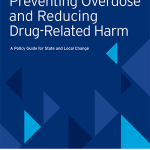Legal & Policy Approaches to Reducing Prescription Drug Overdose — for Facilitators
Tools for Public Health Law Academy trainers
This collection of tools supports anyone interested in teaching public health practitioners about legal and policy approaches that states have adopted to address the overdose epidemic. It is part of the Public Health Law Academy (PHL Academy), which provides a deeper understanding of the use of law and policy to improve population health outcomes.
Start with our Legal & Policy Approaches to Reducing Prescription Drug Overdose training, then download and tailor the following resources for your specific audience:
- Facilitator's Guide that can be customized for your community
- Slide Presentation that can be adapted to your unique training content
About This Training
Opioid overdose is at epidemic levels in the United States. State action, particularly the enactment and enforcement of evidence-based laws and policies, can dramatically affect the risk environment for drug overdose. Many states have responded to the overdose epidemic by changing law and policy to reduce overdose risk at a number of key junctures, from reducing improper prescribing to improving substance abuse treatment and increasing access to emergency overdose treatment.
This training focuses on two law and policy approaches that states have adopted to address the overdose epidemic: (1) Prescription Monitoring Program (PMPs), state-run electronic databases used to track prescribing and dispensing of controlled prescription drugs to patients; and (2) legal changes that increase access to emergency care and treatment for opiate overdose, including the administration of naloxone. The training describes the evidence base for these interventions and presents best practices for their implementation, as suggested by the academic literature and subject matter experts.
Learning Objectives
Instructors can tailor these training materials to achieve the following learning objectives:
- Understand the scope and major causes of the opioid overdose epidemic
- Understand promising policy options such as Prescription Monitoring Programs (PMPs) and naloxone access/overdose Good Samaritan Laws
- Describe best and promising practices for PMPs and naloxone access
- Understand the tools and data available for monitoring and evaluating PMPs, naloxone access initiatives, and overdose Good Samaritan laws

